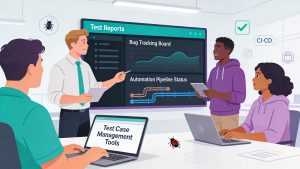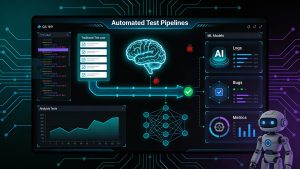In today’s fast-paced software development landscape, manual testing remains a cornerstone for ensuring product quality. Despite the rise of automation frameworks and AI-driven testing platforms, manual testing continues to be critical for usability validation, exploratory testing, and testing edge cases that automation might overlook.
Experienced manual testers are not just bug finders—they are quality advocates who understand the software development lifecycle, business workflows, test strategy formulation, and efficient test execution. Whether you’re interviewing for a QA analyst, test lead, or quality manager role, you’ll face questions that assess your critical thinking, attention to detail, and domain knowledge.
In this blog, we’ll explore the Top 10 Manual Testing Interview Questions and Answers tailored for professionals with 3+ years of experience. These questions are framed to test not only your understanding of testing techniques but also your ability to apply them in real-world scenarios.
1. What’s the difference between severity and priority in bug tracking?
Answer:
- Severity refers to the impact of a defect on the application.
- Priority refers to the urgency with which the defect needs to be fixed.
Example:
text
– High severity, low priority: A crash occurs only when accessing a legacy feature used annually.
– Low severity, high priority: A typo on the login button on the homepage of a live website.
2. What are the key components of a good test case?
Answer:
A well-written test case includes:
- Test Case ID
- Title
- Preconditions
- Test Steps
- Expected Result
- Actual Result
- Test Data
- Postconditions
- Status (Pass/Fail)
- Author and Date
Example Test Case:
text
Test Case ID: TC_01Title: Validate login with valid credentials
Precondition: User has a valid account
Steps:
1. Go to login page
2. Enter username and password
3. Click login
Expected Result: User is redirected to the dashboard
3. Explain the difference between black box testing and white box testing.
Answer:
- Black Box Testing: Focuses on the application’s functionality without knowing its internal code.
- White Box Testing: Involves testing the internal logic and code structure of the application.
Black box is often performed by testers, while white box is usually performed by developers.
4. What is exploratory testing and when would you use it?
Answer:
Exploratory testing is an unscripted, hands-on testing technique where the tester simultaneously learns, designs, and executes tests.
Use cases:
- When there is limited documentation.
- During early iterations of development.
- For discovering edge cases or UX issues.
Tip: It’s great for detecting issues that scripted testing might miss.
5. What are boundary value and equivalence partitioning techniques?
Answer:
These are black-box test design techniques:
- Boundary Value Analysis (BVA):
- Test at the edges of input ranges.
- Example: For input 1–100, test values: 0, 1, 100, 101
- Equivalence Partitioning:
- Divide input data into equivalent groups.
- Example: Input age should be between 18–60
- Valid class: 18–60
- Invalid classes: <18, >60
python
# Sample Python logic for equivalence class:
def is_valid_age(age):
return 18 <= age <= 606. What is the difference between a test plan and test strategy?
Answer:
- Test Plan: Project-specific document outlining scope, schedule, test objectives, resources, deliverables, etc.
- Test Strategy: Organization-wide, high-level document describing the general approach to testing (e.g., levels of testing, test tools).
7. Explain defect life cycle with statuses.
Answer:
The defect life cycle defines various stages a bug goes through:
text
1. New
2. Assigned
3. Open
4. Fixed
5. Retest
6. Verified
7. Closed
(Or Reopen if not fixed)
Example in Jira:
text
Bug Reported → Assigned to Developer → Developer Fixes → QA Retests → Closed if fixed8. How do you perform regression testing manually?
Answer:
Manual regression testing involves:
- Identifying impact areas based on recent code changes.
- Re-executing previously passed test cases from the test suite.
- Validating unchanged modules to ensure no side-effects.
Pro Tip: Always maintain a regression test suite in tools like TestRail or Excel for repeat use.
9. What is the difference between Verification and Validation in testing?
Answer:
- Verification: Ensures the product is being built correctly (design phase).
- Validation: Ensures the correct product is being built (after execution).
text
Verification → Are we building the product right?
Validation → Are we building the right product?
10. What are some key challenges in manual testing and how do you overcome them?
Answer:
Challenges:
- Repetitive tasks
- Limited coverage in time-boxed sprints
- Human error
- Incomplete documentation
Solutions:
- Use test case management tools.
- Prioritize exploratory testing.
- Participate in sprint planning.
- Advocate for hybrid testing (manual + automation for regression).
Conclusion
Manual testing is far from obsolete—in fact, it plays a vital role in ensuring quality, usability, and user satisfaction. As a manual tester, especially at a senior level, your job is not just to run test cases but to understand business logic, collaborate with cross-functional teams, and bring a quality mindset to the entire development lifecycle.
Preparing for interviews means being confident in both technical concepts and practical execution. Make sure to brush up on your documentation, test case writing, bug lifecycle understanding, and real-world QA challenges. Showcase how you’ve contributed to software quality—not just by finding bugs but by improving processes.
With the above questions, you will be better prepared to highlight your experience, communicate clearly, and demonstrate the impact you’ve made in your testing career.
If you’re an experienced manual tester looking to break into top-tier roles across GCCs (Global Capability Centers), Talent500 is your destination. With exclusive partnerships with Fortune 500 companies and high-growth startups, Talent500 connects India’s top talent to the world’s most rewarding tech jobs. Explore remote QA roles, product testing opportunities, and senior test leadership positions—all in one place.



